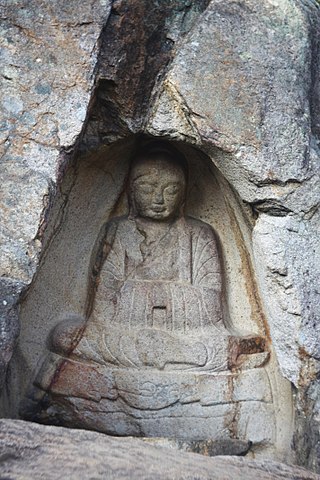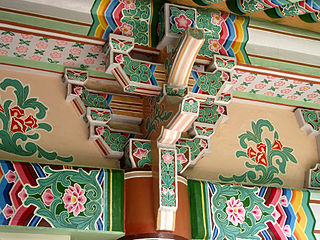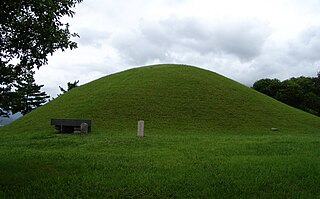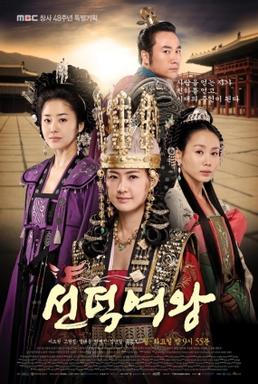
Jeonbuk State, also known as Jeonbuk is a Special Self-governing Province of South Korea in the Honam region in the southwest of the Korean Peninsula. Jeonbuk borders the provinces of South Chungcheong to the north, North Gyeongsang and South Gyeongsang to the east and South Jeolla to the south.

Iksan is a city and major railway junction in North Jeolla Province, South Korea.

Queen Seondeok of Silla reigned as Queen Regnant of Silla, one of the Three Kingdoms of Korea, from 632 to 647. She was Silla's twenty-seventh ruler, and its first reigning queen. She was the second female sovereign in recorded East Asian history and encouraged a renaissance in thought, literature, and the arts in Silla. In Samguksagi, Queen Seondeok was described as "generous, benevolent, wise, and smart". According to the Legend of Jigwi, she was also beautiful. She developed Buddhist culture, selected great talent, and established diplomacy with the Tang Dynasty, laying the foundation for the unification of the Three Kingdoms of Korea. Queen Seondeok is known as a wise and kind monarch, making her one of the most prominent monarchs in Korean history.
Uija of Baekje was the 31st and final ruler of Baekje, one of the Three Kingdoms of Korea. His reign ended when Baekje was conquered by an alliance of the rival Korean kingdom Silla and China's Tang dynasty.

King Mu of Baekje (580?–641) was the 30th king of Baekje, one of the Three Kingdoms of Korea. He was the 4th son of King Wideok.

Mireuksa (Korean: 미륵사) was the largest Buddhist temple in the ancient Korean kingdom of Baekje. The temple was established in 602 by King Mu and is located 36.012083 N, 127.031028 E, modern Iksan, North Jeolla Province, South Korea. The site was excavated in 1980, disclosing many hitherto unknown facts about Baekje architecture. Mireuksaji Stone Pagoda is one of two extant Baekje pagodas. It is also the largest as well as being among the oldest of all Korean pagodas.

Korean architecture refers to an architectural style that developed over centuries in Korea. Throughout the history of Korea, various kingdoms and royal dynasties have developed a unique style of architecture with influences from Buddhism and Korean Confucianism.
King Jinji of Silla was the 25th ruler of the Korean Kingdom of Silla. He was dethroned three years after his accession.

Queen Jindeok of Silla (?–654), reigned as Queen of Silla, one of the Three Kingdoms of Korea, from 647 to 654. She was the kingdom's 28th ruler, and its second reigning queen following her predecessor Queen Seondeok. During her reign, Silla jockeyed with Baekje for favor in the Chinese Tang court. She is also known for writing a poem of the Emperor Gaozong of Tang. According to Samguk Sagi, she was voluptuous, beautiful and tall.

Jinpyeong was the 26th king of the Silla dynasty, one of the Three Kingdoms of Korea. King Jinpyeong followed in the footsteps of his predecessor, King Jinji, by reorganizing the central ruling system of Silla. Upon the onset of a multitude of conflicts between Baekje and Goguryeo, he sent emissaries to improve relations and strengthen ties between Silla and the Chinese dynasties Sui and Tang. He is also known for his promotion of Buddhism as a spiritual guide for the kingdom and encouraging Buddhist teachings.

King Taejong Muyeol (603–661), born Gim Chunchu, was the 29th ruler of Silla, one of the Three Kingdoms of Korea. He is credited for leading the unification of Korea's Three Kingdoms.

Queen Seondeok is a 2009 South Korean historical drama produced by MBC and Time Box Production for the former's 48th founding anniversary, starring Lee Yo-won, Go Hyun-jung, Uhm Tae-woong, Kim Nam-gil, and Park Ye-jin. It chronicles the life of Queen Seondeok of Silla. It aired on MBC from 25 May to 22 December 2009 on Mondays and Tuesdays at 21:55 for 62 episodes.
Queen Maya was a member of the Silla royal house and the wife and queen consort to King Jinpyeong of Silla, 26th King of Silla. She was of the royal Kim clan. She was the mother of Queen Seondeok of Silla.

Gyebaek is a 2011 South Korean period drama series, starring Lee Seo-jin, Cho Jae-hyun, Song Ji-hyo and Oh Yeon-soo. It aired on MBC from July 25 to November 22, 2011 on Mondays and Tuesdays at 21:55 for 36 episodes.
Princess Cheonmyeong was a princess of Silla, one of the Three Kingdoms of Korea. She is known as Queen Seondeok's sister and King Taejong Muyeol's mother.

Dream of the Emperor is a South Korean television series that aired on KBS1 from September 8, 2012 to June 9, 2013 on Saturdays and Sundays at 21:40 for 70 episodes.

Ballad of Seodong is a South Korean television series starring Jo Hyun-jae, Lee Bo-young, and Ryu Jin. It aired on SBS from September 5, 2005 to March 21, 2006 on Mondays and Tuesdays at 21:55 for 55 episodes.

Iksan Mireuksaji Stone Pagoda is located in Mireuksaji, Geumma-myeon, Iksan-si, Jeollabuk-do, and is the oldest stone pagoda remaining in Korea. It is designated as the 11th national treasure.
Queen Sado of the Park clan was a Queen Consort of Silla as the spouse of king King Jinheung of Silla, and the mother of his successor, King Jinji of Silla. According to the disputed text Hwarang Segi, she was regent during the minority of her grandson King Jinpyeong but her regent is not mentioned in the historical texts Samguk sagi or Samguk yusa. She later became a Buddhist nun under the name Myobeop.
The Buyeo Seodong Lotus Festival is an annual seasonal summer festival in South Korea held at Gungnamji, the first man-made pond in the nation, in Buyeo-gun, Chungcheongnam-do.












